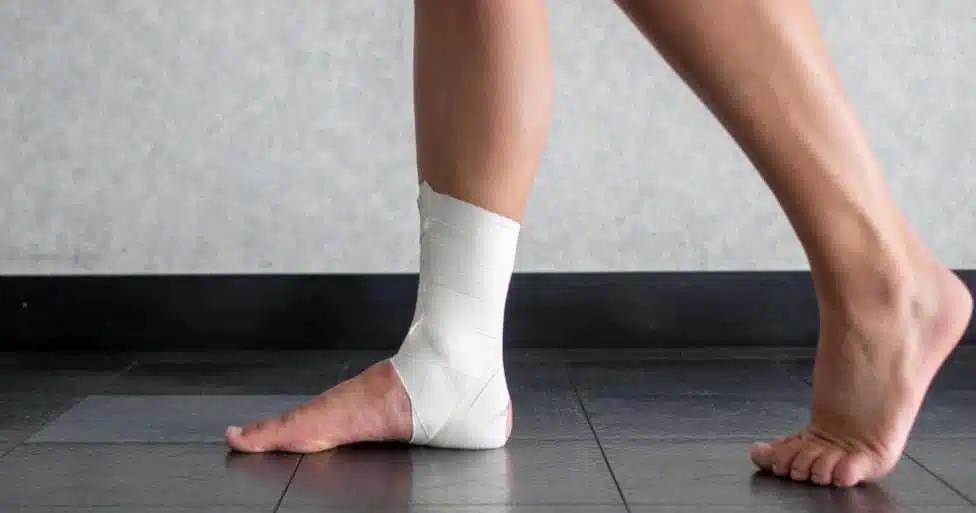Does Ankle Taping Increase The Injury Risk To Adjacent Areas?
Taping your ankle can provide support and stability and is used specifically in physical activities or sports that involves uneven surfaces, rapid changes of direction, jumping and landing, and physical contact with opposition. Useful in protecting the ankle joint, preventing injury to the ankle and assisting a return to these activities following ankle injury, it is however important to recognize that the use of ankle tape or any
external support like an ankle brace (ankle guard) does have potential risks and considerations.
When using ankle strapping techniques, it is crucial to ensure that the tape is applied correctly using proper technique. Just as taping using insufficient taping will likely be ineffective in achieving the goal of reducing injury risk. Improper taping using excessive tension can potentially restrict the natural range of motion, negatively alter joint biomechanics, potentially creating undue stress on surrounding tissues or joints. This hypothetically can increase the risk of injury to those areas.
Ankle Taping Benefits And Risk Are Individual Specific
Any effectiveness and potential risks associated with supportive strapping can vary depending on the individual. The motivation behind taping will vary from one individual to another about the injury and the activity being performed. For some individuals taping may make up a useful part of a comprehensive treatment plan. For others the use of taping or ankle bracing may have a limited role.
Consulting with a sports physio like our team at Sydney Physio Clinic can assess your specific situation, providing appropriate guidance on the potential use of ankle strapping or other forms of support.
Taping is typically not considered a comprehensive rehabilitation plan and a solution to managing an unstable ankle alone. In addition to taping, most physiotherapist would agree it is generally beneficial to focus on strengthening the ankle, improving balance and landing actions as well as addressing any underlying issues through targeted rehabilitation/preventive measures. This can help promote long-term ankle stability and reduce the risk of injury to other tissues or joints.
What Is The Evidence Around Ankle Bracing Increasing Knee Injury Risk
Available research has produced mixed results with some studies having not found any significant association between ankle bracing and knee injury risk. However, others have suggested that certain types of ankle bracing may potentially increase the risk of knee injuries. The consensus is that more research is needed to fully understand the relationship between the use of strapping and ankle braci
ng and knee injury risks. It is likely that individual factors such as pre-existing knee conditions, ankle instability, and the specific activities being performed play a role in the outcomes.
Some studies have indicated that rigid ankle braces (or certain types of lace-up ankle braces) can alter the biomechanics and movement patterns of the lower extremity. This alteration to movement patterns may potentially affect the forces and stresses transmitted to the knee joint, and these altered mechanics may place increased strain on the knee joint, potentially increasing the risk of knee injuries.
Potential risks associated with the use of ankle bracing, ankle taping and knee injuries are not well-established. The benefits of ankle taping in preventing ankle injuries may outweigh any potential risks to the knee in specific situations. Given there is a substantial body of research supporting the effectiveness of ankle bracing and ankle taping in reducing the risk of ankle injuries, particularly during high-risk activities, if appropriate it is probably advisable to support the ankle harvesting the benefits of protecting the ankle over worrying regarding the potential risk of a subsequent knee (or other) injury.
As always, it is advisable to
consult with your sports physio or other appropriately skilled medical practitioner who can assess your specific situation, consider any underlying conditions, and provide appropriate guidance on the use of ankle taping, bracing or other forms of ankle support. Helping you weigh up the potential benefits and risks, providing an educated recommendations tailored to your individual needs.
Is There Any Evidence Ankle Taping Negatively Impacts Foot Biomechanics
There is some evidence to suggest that ankle taping can have an impact on foot biomechanics, although the extent and significance of these changes can vary depending on various factors. Key points from the available research includes:
- Restricted Range of Motion: Ankle taping can limit the range of motion of the ankle joint. This restriction may as a result consequently alter ankle joint motion affecting overall foot and lower limb biomechanics.
- Changes in Muscle Activity: Ankle taping potentially may influence muscle activation patterns (possibly altering the timing, or magnitude of muscle contractions) around the ankle joint. This may affect the balance of muscle forces, potentially impacting foot and lower limb biomechanics.
- Arch Support: Ankle taping can provide some additional support to the foot’s arches and subsequently influence foot alignment. This can result in changes to foot pronation or supination during activities. Alterations to foot arch rolling can impact the distribution of forces along the foot and forces passed on to the lower limb.
It’s important to recognize that individual responses to ankle taping can vary. Based on factors such as foot structure and any existing biomechanical issues. Exact ankle taping techniques used can also influence the extent and nature of the biomechanical changes. And while ankle taping can potentially introduce alterations to foot biomechanics, it is worth noting that these changes may not necessarily be detrimental or harmful to other tissues and joints and may simply achieve what ankle taping is designed to achieve which is
protecting the ankle!
I would suggest that in my experience the benefits of ankle taping, such as reducing the risk of ankle injuries, typically outweigh any potential negative biomechanical changes. But in saying that it is always a good idea seeing a sports physio who can assess your specific needs and provide recommendations tailored to your individual circumstances. This way they can help ensure that taping techniques used are appropriate and properly applied and address any specific concerns.


